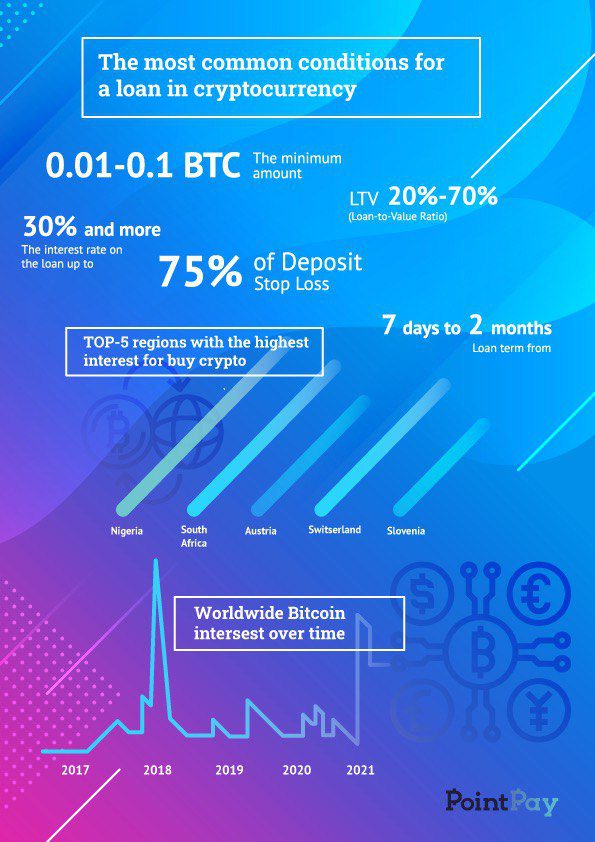According to The World Bank in 2019, loans to the private sector by banks around the world accounted for 90% of global GDP, and interest rates on deposits in the world have not increased for almost 10 years. There is a huge need for money in the world, which banks, for various reasons, cannot satisfy and which is partially “pulled over” by the cryptocurrency. According to the cryptocurrency bank PointPay, the market for crypto loans, where bitcoin and stablecoins are pledged as collateral, is estimated at approximately $ 30-35 billion in 2021 – and it continues to grow.
The Cambridge Center for Alternative Finance in 2020 established there are at least 100 million cryptocurrency users in the world. But this is only the active part of users, the unsatisfied demand for cryptocurrencies, especially during the bull run, is much higher. Interest from both large institutional investors and private investors skyrocketed following the price. So, more than 50% of recipients of incentive payments in the United States are ready to invest them in bitcoin. This suggests that the demand for cryptocurrencies as investments in the presence of free funds from citizens around the world is enormous. Blockchain projects have picked up this trend and are creating cryptocurrency banks that are ready to lend digital money before anyone else. Experts of the world’s first blockchain bank and the PointPay ecosystem talk about where and how you can borrow cryptocurrency.
Not everyone can use the card
The easiest way to borrow digital money would be to buy cryptocurrency directly by paying with a regular credit bank card. But this is not always possible. The classical banking system in many countries is wary of cryptocurrencies. And there are banks that are unfriendly with cryptocurrencies that prohibit buying crypto with a credit card. This is one of the reasons why cryptocurrency loans are so in demand – it’s not always possible to spend money from a credit card on bitcoin just like that. About three dozen banks around the world are unfriendly with cryptocurrencies and prohibit buying them with credit cards, among such banks are institutions in the USA, Canada, Europe, China, India, Australia, and the Middle East: Citygroup, Capital One, Discover, Bank of America, TD Bank, Bank of Montreal, Royal Bank of Canada, Nordea Bank, Danske Bank, Lloyds Bank, and others. The official position is that cryptocurrencies are too volatile and that the collateral cannot be sold, simply taken away from the owner.
In fact, there are fears that cryptocurrencies can shake the traditional banking system: the bank does not have the ability to control the borrower’s cryptocurrency accounts, in the event of a default of cryptocurrencies, clients will go to real banks to revise the loan conditions, and, finally, the third reason is that blockchain technology is much more transparent than banking as we know it.
One way or another, according to Point Pay, about 15-20% of cryptocurrency buyers from more than 200 countries on the platform use a credit card. A 2018 study by Lend Edu announced roughly the same numbers. In 2020, according to The Student Loan Report, 1 out of 5 students in the United States buys cryptocurrency on credit in the hope of getting rich.
Demand is higher than supply
The potential demand for cryptocurrency and for banking services in cryptocurrency is much higher than the existing one. According to PointPay, the interest of the Internet users in buying cryptocurrency, bitcoin, and ether is even higher in some cases than in 2017. This is also confirmed by the data from Google Trends for the requests “buy cryptocurrency”, “bitcoin”, “ethereum”, “binance”.
“The most active recipients of loans secured by cryptocurrency at PointPay are cryptocurrency traders, as well as small blockchain startups. Although there are projects in the world that lend to agribusiness in cryptocurrency, creative and social projects – they all have their own target audience, – says Andrey Svyatov, CEO of Point Pay. “The maximum loan amount on our site is 0.1 BTC, so most consumers are traders and private borrowers who have savings in cryptocurrency, but there is a current need for cash”
Today, the lending market in which bitcoin is the collateral is valued at $25 billion. Bitcoin is a convenient subject of collateral, as it can be easily confirmed that it is owned, and no additional assessments of such collateral are needed, as is the case with real estate or other property.
“But if we add the collateralized stablecoins, we believe the market is even bigger at the moment – about $30-$35 billion, and it has every chance to double in 2021-2022,” says Andrey Svyatov, CEO of PointPay.
Several dozen projects have already been providing loans secured by cryptocurrencies: they can be conditionally divided into centralized and DEFI projects. Centralized is similar to classic lending institutions, where the collateral is placed in cold wallets. Decentralized ones function as a blockchain with a smart contract with certain conditions. Also, the sites where the parties to the transaction agree among themselves, and the conditions depend on the reputation of the site, stand apart. Among the pioneers of cryptocurrency, lending is such companies as PointPay, Binance, Cripterium, Nexo, Kiva, BTCPop, SALT.
“In some countries, cryptocurrency can
not be used as a means of payment and is equated to property. But in this case, it can be used as collateral and use its liquidity, ”explains Andrey Svyatov.
Lending terms
Projects issue loans in cryptocurrency, as a rule, for a short period of time – from several days to several months. Another important parameter is the interest rate – it depends on the currency of the loan and can range from 2% to 30% or more.

The ratio of the loan amount to the collateral – LTV – in different projects ranges from 20% to 70%. That is, the collateral is always higher than the loan itself. So, for example, if you need to lend 50 USDT, then you must provide a deposit of 100 USDT and then LTV = 50%. Also, if the rate goes sharply into the red, then when the balance reaches 75% of the collateral amount, the stop loss is usually triggered and lending is automatically terminated. In many projects, you can pay a commission and take out a loan again.
As a rule, to obtain a loan, a few documents are enough – a passport or an international driving license, as well as proof of residence – on an invoice for any services or a bank statement in your name.
PointPay emphasizes that cryptocurrency loans have a high return rate – more than 90% of loans are returned by borrowers, despite the fact that there are only a few court precedents in the world when a borrower was obliged to repay a debt in cryptocurrency.
The list of cryptocurrencies that can be borrowed is already quite big, so in the PointPay cryptocurrency bank, you can borrow USDT, BTC, ETH, BCH, TRX, LTC, LINK. The collateral is USDT or BTC. There are borrowers on the platform from more than 200 countries of the world, the maximum loan is the equivalent of $5000 – loan term – from 7 days to 2 months. You can also make a deposit in cryptocurrency on the platform – interest is paid daily.
Today, DeFi projects that issue their own tokens are encouraging borrowers to buy them by offering more favorable loan terms. So, in PointPay Crypto Bank, the interest rate directly depends on the number of PXP tokens owned of the PointPay project on the borrower’s account – the more tokens, the lower the annual rate on the loan.
PointPay conducts a pre-sale of its tokens at a reduced price – the initial price is $0.1 for one PXP, at the end of March 2021 this value increased by 50%. Also, the PointPay project has referral programs, for registering using a personal link you can get 25% of the amount of PXP tokens purchased by your referral. PointPay cryptocurrency bank is recognized by many reputable platforms and exhibitions as one of the most promising DeFi projects of 2021.
“The crypto banking revolution hasn’t happened yet. While companies such as PointPay were pioneers in lending and depositing, in the future all major banks are also likely to join the race. The only logical solution for them will be to issue their own cryptocurrencies (they are unlikely to decide to lend in bitcoins or against them), backed by real assets, and this will lead to a global change in the entire banking system,” sums up Andrey Svyatov, CEO Point Pay.
“But since the regulators and the banking system, in general, are clumsy, and the Central Banks of different countries are still testing and writing legislation for their currencies, so far the market belongs to blockchain enthusiasts.”



































